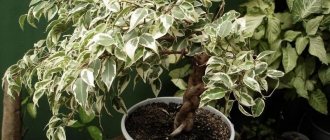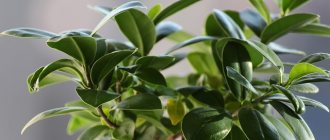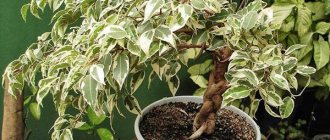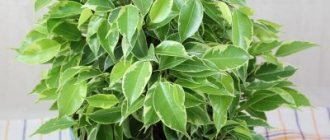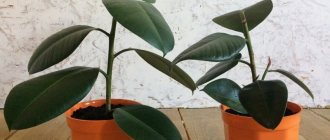Previously, in Soviet Russia, ficus trees were a sign of the bourgeoisie. Now this plant is treated completely differently. In Asian countries, where ficus comes from, it is given special importance. For example, if you give a ficus in China, it means that by default you wish the owner long life and prosperity. In Thailand, ficus is a symbol of the state capital. And in Sri Lanka there is a 150-year-old ficus, which is revered almost as a deity.
Oriental signs also say: if you give a ficus to a childless couple, and it takes root well and begins to grow rapidly, then soon a long-awaited baby will appear in the house.
“When buying ficus Benjamin, remember that it is small and compact only for the first 5 to 7 years,” warns the chairman of the Moscow Flower Growers club, Tatyana Zhashkova. – My ficus is already more than 20 years old, and it has already become a powerful, spreading tree with a voluminous trunk and a crown right up to the ceiling. So be prepared for the fact that over time your pet may require much more space.
Varieties of Ficus Benjamin
Ficus Benjamin (Ficus benjamina) is valued for its beautiful leaves - in species plants they are dark green, oval, 5 - 12 cm long and 2 - 5 cm wide (1). There are a lot of varieties of this ficus, which is not surprising - this plant is very popular among gardeners. And breeders, trying to satisfy requests, came up with very interesting options:
- Anastasia - with green leaves decorated with a light green border;
- Barok is a small-leaved variety whose leaves are twisted into a tube;
- Buklee - with leaves slightly curled inward;
- Wiandi is a small-leaved variety with green leaves and a curved trunk, making the plant look like a bonsai;
- Golden King - it has green leaves with a bright yellow stripe along the edge;
- Golden Monique - with light green-golden leaves, heavily corrugated along the edges, and dark green streaks along the central vein;
- Curly is a slow-growing variety with severely deformed leaves that are mostly white;
- Monique - with green corrugated leaves;
- Naomi - with dark green leaves, slightly wavy along the edges;
- Naomi Gold - its young leaves are light green with dark streaks in the middle, but with age they turn green;
- Samantha (Samantha) - with grayish-green leaves with a thin white stripe along the edge;
- Safari - a small-leaved variety with green leaves decorated with cream specks;
- Starlight - with mostly white leaves, very beautiful, but whimsical: at the slightest violation of care, its leaves fall off.
Ficus Benjamina Starlight. Photo: commons.wikimedia.org
Description
Since ancient times, Australia has been considered the ancestral home of the ficus; today, the ficus has actively spread throughout America, Africa, Asia and India. In Russia it is found on the Black Sea coast and in the Krasnodar region. An evergreen tree or shrub that grows up to 25 m in height in the wild.
Ficus benjamina
Ficus Benjamina, one of the most popular species of evergreen plants. The indoor tree has medium-sized emerald foliage and an erect trunk, sometimes taking on a bizarre shape, in the form of an interweaving of several large shoots, cascading branches, and a bright green lush crown.
The leaf of Ficus Benjamin is smooth, pointed, elliptical in shape, richly green in color or with variegated patches. On average, a ficus leaf grows to 8-9 cm. The branches are flexible, covered with gray, thin bark. With proper care, the plant reaches one and a half meters in height.
A special feature of Ficus Benjamin is its capricious nature.
A tree can easily shed its leaves for no apparent reason, due to the slightest lack of nutrients in the soil, or due to climate change in the room. However, you should not be upset, and “the devil is not as terrible as he is painted,” a couple of fertilizing is enough and the tree will turn green again.
Caring for Ficus Benjamin at home
Ficus Benjamin is generally unpretentious, but is sensitive to serious violations of agricultural practices. And it’s the rare varieties that are most often capricious.
Priming
The soil for Ficus Benjamin should be fertile, moisture-absorbing and breathable. You can buy soil for decorative foliage plants in the store, but it is useful to add turf soil, sand, and leaf humus.
Temperature
Ficus Benjamin is thermophilic - in summer it needs a temperature of 22 - 28 ° C, in winter a little lower - 12 - 16 ° C (2). If it gets cooler, the plant will shed its leaves. And he also hates drafts.
Lighting
This plant requires indirect light. Direct sunlight is contraindicated for it, so it has no place on the southern and eastern windowsill. On these cardinal points it is better to place it on the floor near the window. And on western and northern windows it may well grow on the windowsill.
But this applies to varieties with green leaves. If the leaves of your ficus are decorated with white strokes, spots or a neat border, then this plant needs more light in order for the color to be preserved. But still avoid direct sunlight so as not to burn the plant.
Humidity
Ficus benjamina categorically does not tolerate either drought or overwatering. If there is not enough moisture, the leaves begin to turn yellow and rapidly fall off. And if there is frequent stagnation of moisture in the pan, then the plant begins to hurt - the roots rot. Therefore, half an hour after watering, excess water is poured out of the pan.
Photo: pixabay.com
In winter, when the batteries are working, the plant needs to be sprayed more often than in summer. You can place a container of water next to the pot if you don’t have a humidifier. But in winter you can water less often - once a week or even once a week.
Fertilizers and fertilizers
In the summer, Ficus Benjamin is fed once every 2 weeks with complex fertilizer for decorative deciduous crops or specifically for ficus. In winter, fertilizing is also needed, but much less often - once every 6-7 weeks.
Trimming
Ficus grows quickly, young shoots are very flexible. And if they are not shortened in time, the plant will become excessively long. Therefore, it needs to be trimmed regularly. Moreover, the younger the tree, the better. It will be much more difficult to give shape to the grown, stiff giant.
Pruning is done in the spring, at the end of March - beginning of April. Moreover, they deal with ficus as with trees in the country - they shorten excessively long branches, cut out branches directed into the crown. In summer, trim or pinch shoots that stand out from the overall neat picture. Pruning and pinching stops at the end of September to preserve nutrients in the branches and leaves.
To prevent fungal diseases, the sections can be sprinkled with activated carbon or covered with garden pitch.
Top dressing
Use mineral (Epin at a dosage of 1 ml per 5 liters of water) and organic (manure at the rate of 1 g per 1 liter of water, bird droppings - 5 g per 1 liter of water) fertilizer for ficus or ornamental foliage plants 2 times a month from March to September.
It is advisable to alternate them. You can not only sprinkle the soil with fertilizer, but also add it to the water for spraying the leaves and generously moisten both the foliage and the trunk.
In winter, give the plant a break from fertilizers to provide it with an artificial dormancy period. It is also better to refrain from fertilizing for a month after transplantation.
In addition to chemicals, you can also use folk remedies: dilute 1 tbsp. sugar in 1 liter of water and use it for watering (it is enough to apply this fertilizer twice a season).
Reproduction of ficus benjamina at home
There are two ways to propagate ficus benjamina at home, and neither of them can be called easy.
By cuttings. It is not at all necessary to cut off only the top for this. Lateral layers are also suitable. But it is important to consider several nuances:
- the plant must be mature;
- the base of the future seedling should be semi-lignified, that is, still flexible, but no longer green (green cuttings will not take root, but will simply die), however, if there are only lignified branches, then there is a chance with them too;
- the stem-cutting should have from 4 to 6 unfolded leaves.
The milky juice on the cut should be washed well or removed with a napkin; the lower leaves can also be removed.
If only lignified branches are available, then you need to carefully cut the base into several parts with a sharp knife. To prevent the cuts from touching, you can place a match between them. In this way, we kind of form future roots and stimulate root formation.
Then the cuttings need to be placed in water, or planted in a light seedling substrate or in perlite. If you plant cuttings in the soil, set up something like a greenhouse, covering the top with either a plastic bag, a tall plastic glass, or a cut plastic bottle.
If the apartment is warm enough (not lower than 20 ° C), then roots will form within 2 to 3 weeks. When they become strong (in another couple of weeks), you can transplant the cuttings to a permanent place in the pot. For the first couple of weeks, you can still continue the greenhouse effect by covering the seedling, then remove it and send it on an “adult” voyage.
By layering. This option is suitable for an old adult plant that is reluctant to form young shoots, but is all covered with mature woody shoots.
Carefully, being careful not to touch the wood, make a ring-shaped cut on the bark of one of the shoots, carefully removing the top layer. Treat the exposed plant tissue with a growth stimulator and wrap it in moist sphagnum or a mixture based on it. Carefully secure the structure with film, firmly securing the edges with wire or tape.
After some time, the formed roots will become visible through the film. It must be carefully cut below the roots and planted in the usual way. The cut site on an adult plant must be treated with activated carbon or garden varnish.
How does ficus reproduce?
Ficus propagation occurs by cuttings or rooting leaves. The favorable period for such manipulations is the spring-summer period.
Plant propagation methods:
- Cuttings. A simpler and more common method. It is necessary to select a cutting 9-12 cm long with two pairs of developed healthy leaves. There are two ways to root cuttings: by placing them in a container of water or by immersing them in moist soil. With any method, you need to maintain the air temperature within 26-28 degrees, and to speed up the process, create greenhouse conditions by covering the cuttings with film. The first roots will appear after 10-15 days, and the plant will be ready to be transplanted into a flowerpot. The planting container should not be large, 10 cm in diameter is enough. Rooting will be more effective in greenhouse conditions.
- Rooting a leaf. For this method, you need to separate the leaves closest to the ground and place them in a container of water. To prevent rotting of the petioles, dissolve a tablet of activated carbon or aspirin in water. If the leaves are cut off with part of the stem, then rooting can be carried out in moist soil. In this case, it is necessary to ensure greenhouse conditions and optimal lighting. After the roots appear, young ficus plants are planted in individual small containers.
Transplanting Ficus Benjamin at home
The younger the ficus, the more often it needs to be replanted, because the roots grow as rapidly as the branches. It is advisable to replant young plants (up to 7 years old) every year by transferring them into a slightly larger pot (about 2 - 3 cm larger in diameter, since the roots are actively growing).
Photo: pixabay.com
Older plants are replanted once every 2–3 years, or even less often. Make sure that the roots do not appear from the drainage hole - this will be a sign that the pot for your ficus is already too small.
If the plant is more than 12 years old, then instead of replanting, you can simply replace the layer of top substrate.
Where can I buy? Price range
You can purchase Ficus Benjamin in specialized stores or order online. The cost depends on its variety, height, diameter of the flowerpot and varies from 500 to 10 thousand rubles.
What to do immediately after buying a flower?
A newly purchased plant needs 15–20 days to adapt to new conditions, then it should be replanted, replacing the transport container and substrate.
Expert opinion
Mokhov Andrey Petrovich
Graduated from KubSAU, specialty: agronomy
Ficus does not tolerate frequent moving, so you should immediately choose a permanent place for it.
Ficus benjamina diseases
This type of ficus is susceptible to diseases, so it is important to recognize them as early as possible in order to begin timely treatment.
Root rot. If the roots of a ficus are rotten, the leaves very quickly begin to turn yellow, then darken and fall off. And the cause of this disease is usually waterlogging of the soil.
Root rot can only be treated in its early stages. You need to remove the affected plant, cut off all the rotten roots, wash the roots in a weak solution of potassium permanganate, dry them, and then plant them in a new pot with fresh soil.
If the damage is severe, the plant cannot be saved. But you can take cuttings from it and try to root them.
Anthracnose. Signs of this fungal disease are brown spots on the leaves. Gradually they grow and become like ulcers. Leaves fall. With severe damage, the plant dies.
The drugs Fitosporin or Alirin are suitable for the treatment of this disease (3).
Cercospora blight. This is also a fungal disease, and its first symptoms appear on the underside of the leaves - these are black spots. A diseased plant's leaves begin to turn yellow and fall off, which can lead to its death.
This disease can be cured with the same drugs that are used to treat anthracnose - Fitosporin and Alirin (3).
Pruning and rejuvenation
Ficus should be pruned in early spring, at the beginning of the growing season. This procedure allows not only to form a crown, but also to rejuvenate adult specimens - after pruning, axillary buds awaken, producing new shoots. Regular removal of dry, slow-growing and diseased areas avoids infection of the entire plant.
Reference! In order for the crown to grow evenly, the flowerpot should be regularly rotated relative to the light source.
You can trim the branches depending on the desired shape, but by a maximum of a third. The pruning shears must be sharp and disinfected, and the cut areas must be sprinkled with ash or activated carbon.
Popular questions and answers
We talked about the problems in growing Ficus Benjamin with agronomist-breeder Svetlana Mikhailova.
Where is the homeland of Ficus Benjamin?
This ficus has a fairly wide habitat. It grows in tropical areas of Asia - India, China, Indonesia, the Philippines and northern Australia.
How to choose Ficus Benjamin?
The main thing is that the plant is healthy - without spots on the leaves and bare shoots, which may indicate leaf fall. If possible, remove the plant from the pot and inspect the roots - they should be healthy and free of rot. And remember that varieties with unusual leaf colors are more whimsical; they often do not forgive mistakes in care.
Why do ficus benjamina leaves fall?
The main reasons are lack of light, lack of moisture or, on the contrary, excessive watering, drafts, diseases and pests. To cope with the problem, you need to adjust the care or treat the plant.
Why do the leaves of Ficus Benjamin turn yellow?
The reasons are the same as those that cause leaves to fall off - improper watering, a bad place where the ficus grows (it may not have enough light), drafts, diseases and pests.
To prevent this from happening, it is important to find a suitable place for the ficus, follow the care recommendations and treat it on time. Sources
- Visyashcheva L.V., Sokolova T.A. Industrial floriculture. Textbook for technical schools // M.: Agropromizdat, 1991 – 368 p.
- Tulintsev V.G. Floriculture with the basics of selection and seed production // Stroyizdat, Leningrad branch, 1977 - 208 p.
- State catalog of pesticides and agrochemicals approved for use on the territory of the Russian Federation as of July 6, 2022 // Ministry of Agriculture of the Russian Federation, https://mcx.gov.ru/ministry/departments/departament-rastenievodstva-mekhanizatsii-khimizatsii -i-zashchity-rasteniy/industry-information/info-gosudarstvennaya-usluga-po-gosudarstvennoy-registratsii-pestitsidov-i-agrokhimikatov/
FAQ
Is it possible to leave without care while on vacation?
It is not advisable to leave the ficus for longer than 1 week. At this time, it should be removed from the windowsill so that the plant does not get burned if it is very sunny in your absence. And ask your friends to water your plant. Read more about watering here.
What to do if ficus benjamina drops leaves
The plant gets rid of old leaves within the normal range. However, just in case, adjust the temperature in the room and provide additional lighting. Sometimes a plant falls off if it is moved to a new location or due to drafts.
Or the reason may be more serious: the roots have rotted from excessive watering. In this case, you need to remove the ficus from the pot, cut off the spoiled roots, sprinkle the sections with crushed activated carbon and replant them in a smaller pot with a complete replacement of the soil.
Flowers on ficus benjamina: is it possible?
Rarely blooms at home. If, nevertheless, pea-shaped inflorescences appear on it, then it is better to cut them off, especially if the plant is in poor condition: the ficus spends too much energy on flowering.
When and how to transplant to another pot
It is best to transplant Ficus Benjamin at home in March or April. Young specimens need replanting annually, and adults – once every three to four years. In between, remove the top layer of substrate from the pot and replace it with fresh one.
Replant your ficus as follows. Take the flower out of the old pot with a lump of earth and, using the transfer method, place it in the center of the new pot, where a layer of drainage and a layer of new substrate have already been laid. Fill the voids between the plant and the walls of the pot with soil, shaking the pot slightly. If the room is hot, lightly water the transplanted ficus and spray its crown with a fine spray bottle. If the room is cool, it is better not to water the transplanted plant for a couple of days.
Young Ficus Benjamin bushes should be checked frequently for rapid root growth. To do this, turn the pot over and look at its bottom. The roots may already be peeking out of the drainage holes. If so, rejoice, you got a fast-growing specimen. Without waiting until next spring, you will have to transplant it into a new, slightly larger pot.
What kind of pot do you need?
Choose a clay or ceramic pot for ficus benjamina. The new pot should not be too bulky, just a little larger than the old one. Then the root system of the flower will quickly cope with the development of the entire volume of new soil, and the flower will more easily take root in the new place
Let us immediately pay attention to the size of the pot for creating ficus bonsai - it should be wide and shallow
Suitable soil
The natural habitat of Ficus Benjamin is the humid tropics with their characteristic moisture-absorbing nutritious soil. When growing indoors, you need to buy or prepare a substrate yourself that is similar to its natural composition. For Ficus Benjamin, purchased soil for decorative foliage plants is suitable. You can use the soil for Mulberry plants or Palm trees. Note that ficuses are not very picky about the composition of the soil.
It is only important that it is nutritious, breathable and has neutral acidity. Self-prepared soil should be like this: a mixture of peat, garden soil and sand in equal parts
You can add a little wood ash to eliminate the acidity of the soil. Adult specimens require a denser substrate, so turf soil and humus should be added to this soil composition.
Kinds
Experts have bred a great variety of different types of Ficus Benjamin. The differences between them usually lie in the color, shape and size of the leaves.
Here are some of these varieties:
Barok is unpretentious, very similar to a miniature tree and has many subspecies with leaves of different shapes and colors.
Baroque
Anastasia - distinguished by an original pattern of leaves, it is very catchy and patterned.
Anastasia
Starlight - its feature is variegated leaves with white or cream spots on a green background.
Starlight
Golden King - this plant fully lives up to its name; it is the real king of ficus trees. It grows well, allows the formation of beautiful tall trees, and has a noble color of leaves with a golden edge.
Ficus Golden King
Variegated - this handsome guy really doesn’t like to change his surroundings. When purchasing it, find a permanent place for the plant to live.
Variegated
Daniel is a bright, cheerful green representative of the Benjamin ficus. Not as demanding on conditions as its variegated counterparts.
Daniel
Benjamin Mix is a magnificent representative of the genus, which can have leaves of a wide variety of colors - from plain to variegated. Whimsical and requires a lot of attention.
Ficus benjamina Mix
Kinky - easily tolerates haircuts and allows you to form any crown. Also, it is from Kinki that graceful trees with several trunks are “weaved”.
Kinky
Natasha is a dwarf variety of Benjamin with a compact, beautiful crown and variegated oval leaves.
Ficus Natasha
